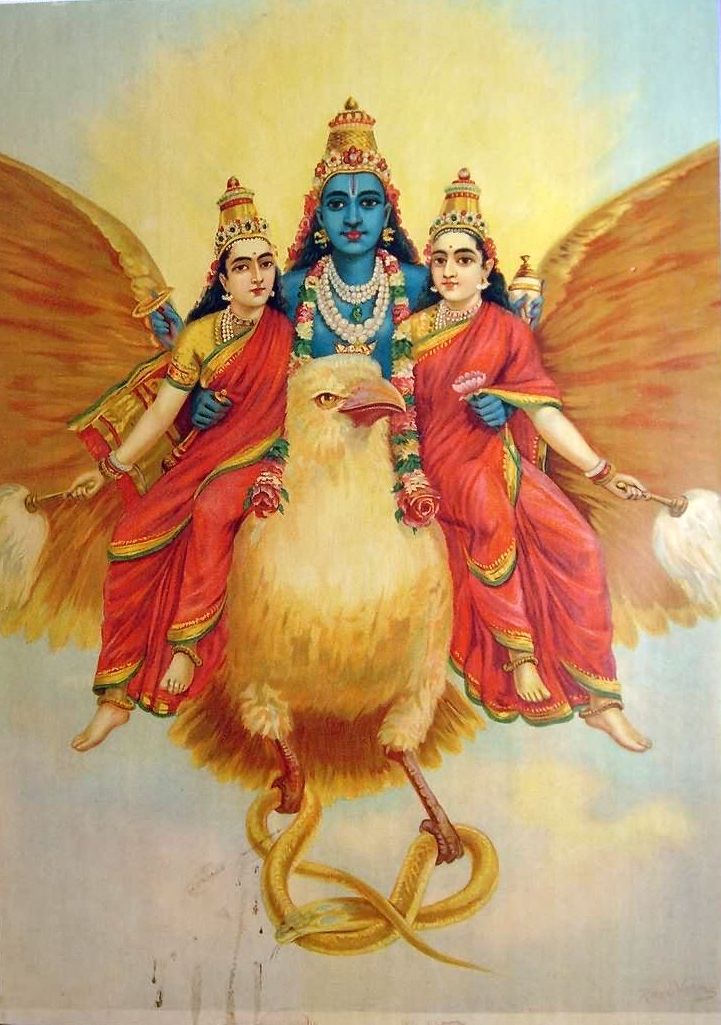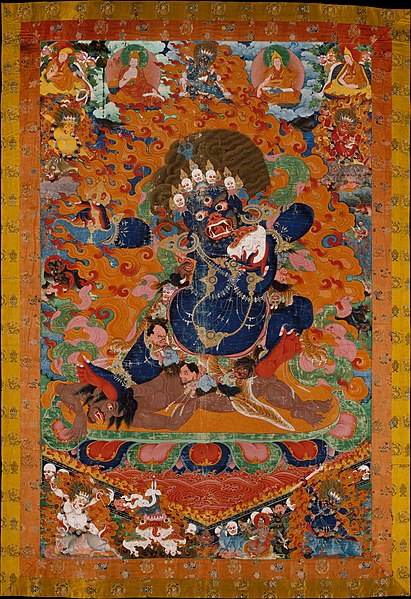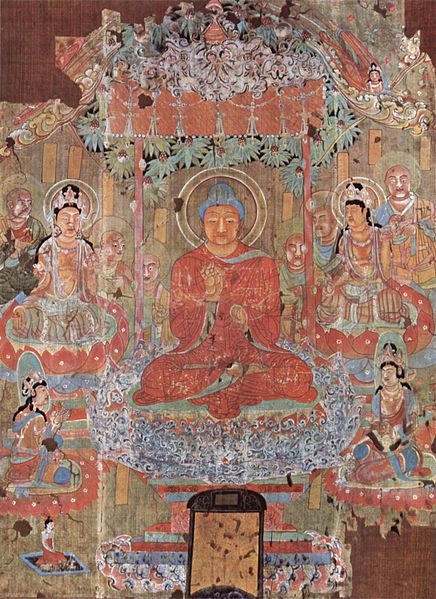1. The coolest thing Zelazny structurally does is to make Sam fail constantly. Sam shoots from the hip an awful lot, and mostly misses: he frees the demons and becomes possessed, he attempts to steal the thunder chariot and gets taken captive, he battles the gods and loses—there are more examples. Though Sam loses battles, he messes up in ways that he can turn to his benefit: by being possessed, he befriends the demon; by being captured, he has opportunity to proselytize the gods; by battling the gods, he sews doubt in their minds and in man's. He takes what comes to him and finds any advantage to draw from it. This isn't a pulp trick though: it's not John Carter falling while fighting, then sitting and stewing until some deus ex machina frees him, then going straight back to the fighting. Rather, Sam risks and loses, but makes the most of it, turns it to his advantage in a way that doesn't rely on hitherto unknowns or outside forces, but through the characters themselves in an honest way, not shying away from what would be a corner a lesser writer would've written themselves into. Something is lost and something is gained. Afterwards, instead of sticking to the same plan in the same way and trying again, that plot element is concluded and Sam moves on. This tactic of Zelazny's is subtle, but a big difference. This is not cheap storytelling. It comes off sophisticated and complex. Brilliant. (Though a counterpoint would be the mother of the glow, which is a deus ex machina)
2. The world building inspires awe. Zelazny starts right in with the characters in the world. He stays with them throughout. It's all the characters, and through them the world-building happens. For instance, in the opening of the book Yama operates a prayer-machine. The reader has no clue what a prayer-machine is other than the clue the name itself gives. This machine and the way the characters interact while using it gives a sense of the world. He doesn't stop the action to explain the technology, but he does give the basics: what a machine does, why the character is using it, and some context of whether the machine is for mortals or gods. These explanations arise naturally, are not overly wordy, and are not overly complex—they only give one more layer to the depth of the technology, keeping the focus on characters and plot and ideas while intruding as little as possible into the narrative. Some of these explanations arise in dialogue, as does much of the fictional history: two characters referencing a shared experience while introducing it to the reader. This is how the world-building is accomplished: the focus stays on the characters, goals, and actions rather than the technology or traditional world-building by narrator. With the prayer-machine, which is quickly explained, he builds trust in the reader, and I trust him to explain things as needed from there on. By not intro-info-dumping, he draws out the world building throughout the novel, which keeps the reader discovering new ideas. By the end I have a great sense of the world. Again it's not cheap or pulpy, but incredibly sophisticated: he focuses on the characters and uses them to build the world naturally and slowly. He doesn't use this tactic to excuse any deus ex machina later. (Except the mother of the glow)
3. But the structure isn't all perfect, unfortunately. That ending drags on in a way that feels like Zelazny lost his path. It's longwinded and introduces new characters and continents in a wild proliferation of plot threads spreading out and too heavily indicating a sequel, which was never written. Six and a half chapters of this novel are structured perfectly, while half a chapter drags.
4. The main structural risk is starting in the middle, then backtracking to another starting point in the past, then surpassing the original starting point to an ending point in the future. This works, but I think it could have been a bit more clear. I initially missed it and was quite confused for a couple of paragraphs.
5. I had a hard time keeping some of the minor characters straight. Because everything flows so well and keeps on moving without major pauses, some of the characters are not clear before the tale moves on, causing minor confusion. Plus, each character has so many names. Their myriad-names convey the serial nature of their mind transfers, sure, but also obfuscate who is who.
6. The novel happens in stages of action and reflection, attempting to meld the two and mostly succeeding. What I mean is that a lengthy action passage will be followed up by a lengthy passage where not much physically happens, but it reflects on the action that just occurred and the action that is about to occur. The novel is almost a 50-50 split of reflection and action, which fits the setting and themes well.
7. It's refreshing to have any author treat another culture this fairly: he is not stereotyping, he's writing complex and conflicted humans who happen to be Hindu, Buddhist, or Christian. Indian themes run through the novel, but never feel like cheap window dressing. Instead I came away with a sense that Zelazny embarked on a truly massive research project before writing this. He method-writes this, inhabiting parts of the culture to tell this tale.
8. The broad writing tactic mixes science fiction story with fantasy word choices, descriptions, and sentence structures. I wouldn't have thought this possible to this level of success. But Zelazny pulls it off, effectively embracing and illuminating the fantastic inherent in science fiction. He also allows that fantastic and utter incomprehensibility to cause the writing. All things are described as mythical, through deeply paradoxical, incantational, and mystical language. It's a gripping voice. Let me give four examples:
His followers called him Mahasamatman and said he was a god. He preferred to drop the Maha- and the -atman, however, and called himself Sam. He never claimed to be a god, but then he never claimed not to be a god. Circumstances being what they were, neither admission could be of any benefit. Silence, though, could.
The high-frequency prayers were directed upward through the atmosphere and out beyond it, passing into that golden cloud called the Bridge of the Gods, which circles the entire world, is seen as a bronze rainbow at night and is the place where the red sun becomes orange at midday.
"I shall tear these stars from out the heavens, and hurl them in the faces of the gods, if this be necessary. I shall blaspheme in every Temple throughout the land. I shall take lives as a fisherman takes fish, by the net, if this be necessary. I shall mount me again up to the Celestial City, though every step be a flame or a naked sword and the way be guarded by tigers. One day will the gods look down from Heaven and see me upon the stair, bringing them the gift they fear most. That day will the new Yuga begin."This writing is simply fun to read. The names also contribute to this wonderful voice. Zelazny avoids overwhelming the readers with made up, pseudo-historical names by using familiars like Buddha and Shiva, but also by using explanatory names: Lord of Light, God of Fire, Garden of Joy, Purple Grove, etc. These explanatory names are perfect: they both explain and give a sense of the importance that calling a city Keenset doesn't have without the further explanation of Keenset's technological advance and the battle. For instance, Purple Grove implies that it's unique and tells what's unique about it in the same breath. Zelazny's voice here is stunning.
The day of the battle dawned pink as the fresh-bitten thigh of a maiden. A small mist drifted in from the river. The Bridge of the Gods glistened all of gold in the east, reached back, darkening, into retreating night, divided the heavens like a burning equator. [...] There were no clouds in the heavens. The grasses of the plain were still moist and sparkling. The air was cool, the ground still soft enough to gather footprints readily.
9. The theme is traditional versus advancement, old versus new, the powerful few versus the powerless many. From the very start, with the prayer machine, the reader begins to get a sense of this theme. And all throughout, this theme is drilled home by the plot, the dialog, the monologue, and the setting. The demons are a powerless many, yet they still threaten Sam. Sam fights the gods, not by brilliant battle, but rather by shifting the rules of the game to favor the many, the new, advancement. The theme runs through this entire novel, influencing every word. It's a fascinating look at a space colony gone native en masse, at how pinched resources can affect a whole planet of people and their social structures, at how adopting a pose eventually causes your face to stick that way. It's engaging and has a satisfying depth.







No comments:
Post a Comment